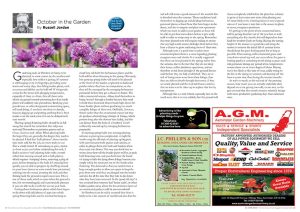
Gardening tasks in October are likely to be dictated, to some extent, by the weather and especially how cold it is getting. If summer is still hanging on by its fingertips, providing some warm and sunny days, then lifting tender plants, such as cannas and dahlias can be held off. If things take a turn for the worse with plunging temperatures, especially if there is a frost, then all those tasks which are geared towards protecting less than hardy plants will suddenly take precedence. Readying your greenhouse, or other designated overwintering space, will need doing, if you have not done so already, because digging up and potting anything that is frost tender is on the cards even if it can be delayed until next month.
Planting spring flowering bulbs should be in full swing this month but remember that tulips can wait until November so prioritise genera such as Crocus, Narcissus and Allium. When planting bulbs the larger they are, generally, the deeper they need to be planted. I find that ‘bulb planters’, those circular type tools sold for the job, are more tricky to use than a sturdy trowel. If naturalising in grass, mown as short as you can before undertaking this task, I find it easier to ‘stab’ planting holes with a trowel rather than messing around with a bulb planter, which requires ‘stamping’ down, removing a plug of grass, before dropping in the bulb. It’s amazing how quickly you are able to progress by shuffling around on your knees (invest in some comfy knee protectors) stabbing into the sward, inserting the bulb and then firming back the ground in rapid succession. This is one of those tasks which is easier when the ground is wet, but not waterlogged, and is particularly pleasant if you are able to do it with the sun on your back.
Cutting down herbaceous plants which have begun to die down will yield plenty of gaps into which spring flowering bulbs can be inserted but keep in mind how tall both the herbaceous plants and the bulb will be when flowering in the spring. Obviously, low growing spring bulbs will need to be planted at the front of the border, or planted in dedicated patches where they have no competition, or else they will be swamped by the emerging herbaceous perennials before they get a chance to flower. The taller ornamental onions, Allium, lend themselves to being ‘woven’ through a border because they tend to hold their drumstick flower heads high above the lower border plants without producing too much unsightly foliage of their own.
Daffodils, Narcissus, flower earlier than the ornamental onions but they do produce relatively large clumps of foliage, which persists long after the flowers have faded, and this can detract from the look of a border if it isn’t sufficiently covered up by emerging herbaceous perennials.
If inserting spring bulbs into existing planting schemes is proving too complicated, it might be worth using the old trick of planting up big pots, with your favourite bulb species and varieties, in order to plunge them into beds and borders when they come into flower. This way you don’t have to worry about how tall the border plants will be, at peak bulb flowering time, and you don’t have the hassle of trying to hide the dying down foliage because you simply whisk the entire pot out of the border after flowering. The downside is that you need to have a large enough garden to allow you space to keep the pots from now until they are plunged into the border and also for all the time that they take to die down after they have been removed. In the ‘good old days’ it was assumed that everyone had ‘frame yards’, or other hidden garden areas, where the less attractive facets of an ornamental garden could be accommodated!
In October it can be safely assumed that there is likely to be a fair amount of rainfall and also that the soil will still retain a good amount of the warmth that it absorbed over the summer. These conditions lend themselves to digging up and dividing herbaceous perennial plants, at least those that have begun to die down, and also to acquire and plant new specimens which you want to add to your garden as these will be able to get their roots down before it gets really cold in order to romp away in the spring. Remember that trees planted now will require staking to ensure that any high winds cannot dislodge them before they have a chance to grow anchoring roots of their own.
Although now is a good time to plant most ornamental plants there is a caveat regarding planting evergreen trees and shrubs. It is usually suggested that these are best planted in the spring, rather than the autumn, due to the fact that they do not drop their leaves, unlike deciduous specimens, and are therefore at risk from drought if the ground freezes solid before they are fully established. They are at risk of losing more water from their foliage, than they are able to absorb through their roots, if they are newly planted and the root ball freezes solid so that no water can be taken up to replace that lost by transpiration.
Although this is a risk I think, especially here in the south west, that it is very unlikely that the ground will freeze completely solid before the plant has a chance to grow at least some new roots after planting out. It’s more likely to be a limiting factor in very exposed sites or if you leave it very late in the season to plant, or move, evergreen specimens.
It’s getting to the point where ornamental lawns will be getting their last cut of the year but, as with everything else this month, this will depend on how kind the weather Gods are being. Raising the cutting height of the mower is a good idea and using the mower to remove the initial fall of autumn leaves should keep the grass looking good for as long as possible. Over-sowing, with ornamental grass seed mixed into sieved top soil, any areas where the grass is looking patchy is something worth doing as grass seed will germinate during any period when temperatures remain above six or seven degrees Celsius. Drying out is less likely at this time of year, unlike trying to do this in the spring or summer, and keeping off the lawn is easier now than during the warmer months.
As with so much, at this tail end of the growing season, how much you can actually undertake does depend on it not getting too cold, or too wet, so fingers crossed that this month remains relatively benign with more productive gardening days than inclement ones.




